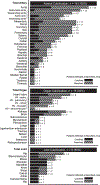Prospective phenotyping of long-term survivors of generalized arterial calcification of infancy (GACI)
- PMID: 33005041
- PMCID: PMC7867608
- DOI: 10.1038/s41436-020-00983-0
Prospective phenotyping of long-term survivors of generalized arterial calcification of infancy (GACI)
Abstract
Purpose: Generalized arterial calcification of infancy (GACI), characterized by vascular calcifications that are often fatal shortly after birth, is usually caused by deficiency of ENPP1. A small fraction of GACI cases result from deficiency of ABCC6, a membrane transporter. The natural history of GACI survivors has not been established in a prospective fashion.
Methods: We performed deep phenotyping of 20 GACI survivors.
Results: Sixteen of 20 subjects presented with arterial calcifications, but only 5 had residual involvement at the time of evaluation. Individuals with ENPP1 deficiency either had hypophosphatemic rickets or were predicted to develop it by 14 years of age; 14/16 had elevated intact FGF23 levels (iFGF23). Blood phosphate levels correlated inversely with iFGF23. For ENPP1-deficient individuals, the lifetime risk of cervical spine fusion was 25%, that of hearing loss was 75%, and the main morbidity in adults was related to enthesis calcification. Four ENPP1-deficient individuals manifested classic skin or retinal findings of PXE. We estimated the minimal incidence of ENPP1 deficiency at ~1 in 200,000 pregnancies.
Conclusion: GACI appears to be more common than previously thought, with an expanding spectrum of overlapping phenotypes. The relationships among decreased ENPP1, increased iFGF23, and rickets could inform future therapies.
Keywords: ABCC6 deficiency; ENPP1 deficiency; autosomal recessive hypophosphatemic rickets type 2; generalized arterial calcification of infancy; pseudoxanthoma elasticum.
Conflict of interest statement
- Conflict of Interest:
Drs. Ferreira, Gafni and Gahl and Ms. Hackbarth report a collaboration with Inozyme Pharma as part of a Cooperative Research and Development Agreement (CRADA). Inozyme is developing ENPP1 as therapy for ARHR2 and GACI. Sisi Wang and Kerstin Müller are employees of ICON plc, a contract research organization.
Figures



Comment in
-
Correspondence on "Prospective phenotyping of long-term survivors of generalized arterial calcification of infancy (GACI)" by Ferreira et al.Genet Med. 2021 Oct;23(10):2006-2007. doi: 10.1038/s41436-021-01228-4. Epub 2021 Jun 14. Genet Med. 2021. PMID: 34127825 No abstract available.
-
Response to Stern et al.Genet Med. 2021 Oct;23(10):2008. doi: 10.1038/s41436-021-01229-3. Epub 2021 Jun 16. Genet Med. 2021. PMID: 34135486 Free PMC article. No abstract available.
References
Publication types
MeSH terms
Substances
Supplementary concepts
Grants and funding
LinkOut - more resources
Full Text Sources
Miscellaneous

